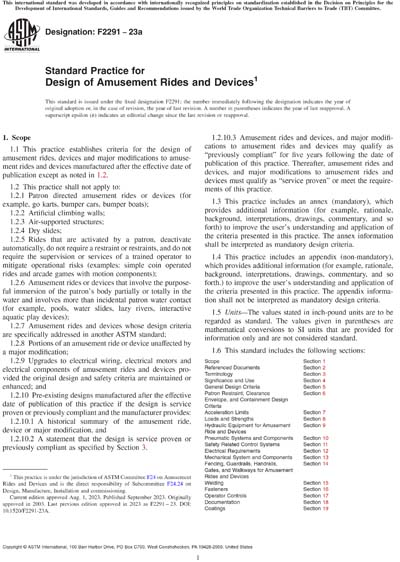Historical
ASTM F2291-23a
Standard Practice for Design of Amusement Rides and Devices
1.1 This practice establishes criteria for the design of amusement rides, devices and major modifications to amusement rides and devices manufactured after the effective date of publication except as noted in 1.2.
1.2 This practice shall not apply to:
1.2.1 Patron directed amusement rides or devices (for example, go karts, bumper cars, bumper boats);
1.2.2 Artificial climbing walls;
1.2.3 Air-supported structures;
1.2.4 Dry slides;
1.2.5 Rides that are activated by a patron, deactivate automatically, do not require a restraint or restraints, and do not require the supervision or services of a trained operator to mitigate operational risks (examples: simple coin operated rides and arcade games with motion components);
1.2.6 Amusement rides or devices that involve the purposeful immersion of the patron's body partially or totally in the water and involves more than incidental patron water contact (for example, pools, water slides, lazy rivers, interactive aquatic play devices);
1.2.7 Amusement rides and devices whose design criteria are specifically addressed in another ASTM standard;
1.2.8 Portions of an amusement ride or device unaffected by a major modification;
1.2.9 Upgrades to electrical wiring, electrical motors and electrical components of amusement rides and devices provided the original design and safety criteria are maintained or enhanced; and
1.2.10 Pre-existing designs manufactured after the effective date of publication of this practice if the design is service proven or previously compliant and the manufacturer provides:
1.2.10.1 A historical summary of the amusement ride, device or major modification, and
1.2.10.2 A statement that the design is service proven or previously compliant as specified by Section 3.
1.2.10.3 Amusement rides and devices, and major modifications to amusement rides and devices may qualify as “previously compliant” for five years following the date of publication of this practice. Thereafter, amusement rides and devices, and major modifications to amusement rides and devices must qualify as “service proven” or meet the requirements of this practice.
1.3 This practice includes an annex (mandatory), which provides additional information (for example, rationale, background, interpretations, drawings, commentary, and so forth) to improve the user's understanding and application of the criteria presented in this practice. The annex information shall be interpreted as mandatory design criteria.
1.4 This practice includes an appendix (non-mandatory), which provides additional information (for example, rationale, background, interpretations, drawings, commentary, and so forth.) to improve the user's understanding and application of the criteria presented in this practice. The appendix information shall not be interpreted as mandatory design criteria.
1.5 Units—The values stated in inch-pound units are to be regarded as standard. The values given in parentheses are mathematical conversions to SI units that are provided for information only and are not considered standard.
1.6 This standard includes the following sections:
| Scope | Section 1 |
| Referenced Documents | Section 2 |
| Terminology | Section 3 |
| Significance and Use | Section 4 |
| General Design Criteria | Section 5 |
| Patron Restraint, Clearance Envelope, and Containment Design Criteria | Section 6 |
| Acceleration Limits | Section 7 |
| Loads and Strengths | Section 8 |
| Hydraulic Equipment for Amusement Ride and Devices | Section 9 |
| Pneumatic Systems and Components | Section 10 |
| Safety Related Control Systems | Section 11 |
| Electrical Requirements | Section 12 |
| Mechanical System and Components | Section 13 |
| Fencing, Guardrails, Handrails, Gates, and Walkways for Amusement Rides and Devices | Section 14 |
| Welding | Section 15 |
| Fasteners | Section 16 |
| Operator Controls | Section 17 |
| Documentation | Section 18 |
| Coatings | Section 19 |
| Fall Protection | Section 20 |
| Sanitation/Disinfection | Section 21 |
| Keywords | Section 22 |
| Loads and Strengths | Annex A1 |
| Patron Restraint, Clearance Envelope, and Containment Design Criteria | Appendix X1 |
| Acceleration Limits | Appendix X2 |
| Degradation Due to Environmental Conditions | Appendix X3 |
| Electrical Requirements | Appendix X4 |
| Mechanical Systems and Components | Appendix X5 |
| Fencing, Guardrails, and Handrails for Amusement Rides and Devices | Appendix X6 |
| Supervising Companion and Clearance Envelope | Appendix X7 |
| Riders Under 48 in. (1.22 m) | Appendix X8 |
| Load/Unload Area Hazard Mitigation Strategies | Appendix X9 |
| Other Acceptable Fall Protection Configurations (14.8) | Appendix X10 |
| Impact Events | Appendix X11 |
| Loads and Strengths | Appendix X12 |
1.7 This standard does not purport to address all of the safety concerns, if any, associated with its use. It is the responsibility of the user of this standard to establish appropriate safety, health, and environmental practices and determine the applicability of regulatory limitations prior to use.
1.8 This international standard was developed in accordance with internationally recognized principles on standardization established in the Decision on Principles for the Development of International Standards, Guides and Recommendations issued by the World Trade Organization Technical Barriers to Trade (TBT) Committee.
ASTM International [astm]

